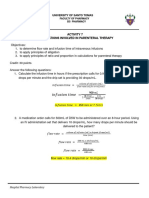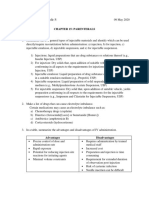A Clinician's Guide To Oral Extended-Release Drug Delivery Systems in Epilepsy
A Clinician's Guide To Oral Extended-Release Drug Delivery Systems in Epilepsy
Uploaded by
JANNIE BELLE RODRIGUEZCopyright:
Available Formats
A Clinician's Guide To Oral Extended-Release Drug Delivery Systems in Epilepsy
A Clinician's Guide To Oral Extended-Release Drug Delivery Systems in Epilepsy
Uploaded by
JANNIE BELLE RODRIGUEZOriginal Description:
Original Title
Copyright
Available Formats
Share this document
Did you find this document useful?
Is this content inappropriate?
Copyright:
Available Formats
A Clinician's Guide To Oral Extended-Release Drug Delivery Systems in Epilepsy
A Clinician's Guide To Oral Extended-Release Drug Delivery Systems in Epilepsy
Uploaded by
JANNIE BELLE RODRIGUEZCopyright:
Available Formats
A Clinician's Guide to Oral Extended-Release Drug
Delivery Systems in Epilepsy
James W. Wheless, MD and Stephanie J. Phelps, PharmD
Clinical Effectiveness: Oral administration will remain the dominant route of AED delivery to treat
epilepsy, and oral Extended Release systems are a valuable tool for achieving improved adherence and
seizure control, and reduced toxicity.
Patient acceptance: Extended-release formulations can allow for reduction in dose frequency, which
may enhance convenience and thereby improve adherence.
Patient adherence: The main benefit is that use of ER formulations improves adherence, which may
reduce downstream direct and indirect costs associated with care and hospitalization. However, formal
studies on the financial impact of ER formulations are lacking and are needed.
Bioequivalence: There are clear benefits for the use of ER formulations compared with IR formulations,
and that ER formulations should be used for most patients with epilepsy, when appropriate for the
patient, and when available for their prescribed medication.
Cost: In general, compared with IR formulations, the manufacturing process and development of ER
formulations are more technologically complex and time-consuming, consequently translating into
higher production costs.
You might also like
- Preparation #15: Magnesium Citrate Oral Solution Post Lab QuestionsDocument1 pagePreparation #15: Magnesium Citrate Oral Solution Post Lab QuestionsJANNIE BELLE RODRIGUEZ100% (1)
- Hospital Documentation ActivityDocument4 pagesHospital Documentation ActivityJANNIE BELLE RODRIGUEZNo ratings yet
- Sterile CompoundingDocument52 pagesSterile Compoundingtabletvoda100% (4)
- Preparation #19: Iso-Alcoholic Elixir Post Lab QuestionsDocument1 pagePreparation #19: Iso-Alcoholic Elixir Post Lab QuestionsJANNIE BELLE RODRIGUEZNo ratings yet
- Now 1&refreqid Excelsior:&seq 4#pa Ge - Scan - Tab - ContentsDocument5 pagesNow 1&refreqid Excelsior:&seq 4#pa Ge - Scan - Tab - ContentsJANNIE BELLE RODRIGUEZNo ratings yet
- Ha in SupplementDocument8 pagesHa in SupplementsimcassNo ratings yet
- Patient Education and Adherence to Aerosol TherapyDocument17 pagesPatient Education and Adherence to Aerosol Therapybenjamin.heng.mkNo ratings yet
- ResearchDocument6 pagesResearchjinny1_0No ratings yet
- Effect of Pharmacy Intervention To Patient With Polypharmacy - JournalDocument7 pagesEffect of Pharmacy Intervention To Patient With Polypharmacy - Journalanon_529380518No ratings yet
- Intervenções FarmaceuticasDocument22 pagesIntervenções FarmaceuticasPhilipe VieiraNo ratings yet
- Book 9781585284030 Ch031-PreviewDocument2 pagesBook 9781585284030 Ch031-PreviewKyaw Han Thar Myint100% (1)
- Pharmacist EvaluationDocument1 pagePharmacist Evaluationosama nagarNo ratings yet
- Geriatrics and TheDocument7 pagesGeriatrics and TheJEFFERSON MUÑOZNo ratings yet
- Joanne Bernadette C. Aguilar Bsn-3Document3 pagesJoanne Bernadette C. Aguilar Bsn-3Joanne Bernadette AguilarNo ratings yet
- Improved Adherence With Once-Daily Versus Twice-Daily Dosing of Mometasone Furoate Administered Via A Dry Powder Inhaler: A Randomized Open-Label StudyDocument9 pagesImproved Adherence With Once-Daily Versus Twice-Daily Dosing of Mometasone Furoate Administered Via A Dry Powder Inhaler: A Randomized Open-Label Studyminerva_stanciuNo ratings yet
- Retina Clinica Trials Update - 0813 - Supp2Document16 pagesRetina Clinica Trials Update - 0813 - Supp2cmirceaNo ratings yet
- Activity No. 9 Pharmacoeconomic Methodologies I. ObjectivesDocument3 pagesActivity No. 9 Pharmacoeconomic Methodologies I. ObjectivesGabriel PatalodNo ratings yet
- Clinical Pharmacist in ICUDocument26 pagesClinical Pharmacist in ICUApriyanNo ratings yet
- Chemotherapy-Associated Oral Sequelae in Patients With Cancers Outside The Head and Neck RegionDocument10 pagesChemotherapy-Associated Oral Sequelae in Patients With Cancers Outside The Head and Neck RegionNndaydnaNo ratings yet
- Updates in EnhancedDocument12 pagesUpdates in EnhancedJEFFERSON MUÑOZNo ratings yet
- Pediatrics 2000 Johnson 1006 12Document9 pagesPediatrics 2000 Johnson 1006 12Amelia ArnisNo ratings yet
- Shetty Et Al. 2008Document10 pagesShetty Et Al. 2008EmmanuelRajapandianNo ratings yet
- Jurnal ErasDocument6 pagesJurnal ErasFadhilNo ratings yet
- Halaman 13 24 PDFDocument12 pagesHalaman 13 24 PDFSiti RahmahNo ratings yet
- Rosenfeld Et Al: Adverse Events, Adherence To Therapy, and Cost Patient CounselingDocument12 pagesRosenfeld Et Al: Adverse Events, Adherence To Therapy, and Cost Patient CounselingSiti RahmahNo ratings yet
- Stress Ulcer Prophylaxis GuidelinesDocument9 pagesStress Ulcer Prophylaxis GuidelinesHAIDAR RACHMANNo ratings yet
- The Effect of Cryotherapy On The Prevention of Oral Mucositis and On TheDocument7 pagesThe Effect of Cryotherapy On The Prevention of Oral Mucositis and On ThePaola GilNo ratings yet
- Ed Pharmacist Article 2004Document4 pagesEd Pharmacist Article 2004Aldhie Poetra BangsaNo ratings yet
- Surgery of Gastroesophageal Reflux Disease: A Competitive or Complementary Procedure?Document10 pagesSurgery of Gastroesophageal Reflux Disease: A Competitive or Complementary Procedure?Yigit İskurtNo ratings yet
- New Oral Care With ClorhedineDocument10 pagesNew Oral Care With ClorhedineZil FadilahNo ratings yet
- Implementation of Clinical Decision Support in Young Children With Acute Gastroenteritis: A Randomized Controlled Trial at The Emergency DepartmentDocument9 pagesImplementation of Clinical Decision Support in Young Children With Acute Gastroenteritis: A Randomized Controlled Trial at The Emergency DepartmentSitri wiyantikaNo ratings yet
- Extemporaneous Compounding of Oral Liquid Dosage FormulationsDocument29 pagesExtemporaneous Compounding of Oral Liquid Dosage FormulationsElizabeth Collins100% (1)
- Endocarditis: Un Estudio de Cohorte Multicéntrico, RetrospectivoDocument8 pagesEndocarditis: Un Estudio de Cohorte Multicéntrico, RetrospectivoMelendi NavarroNo ratings yet
- Thrombosis Journal: Oral Heparin: Status ReviewDocument7 pagesThrombosis Journal: Oral Heparin: Status ReviewGeusan NariswariNo ratings yet
- Objectively Measured Vs Self-Reported Compliance During Oral Appliance Therapy For Sleep-Disordered BreathingDocument8 pagesObjectively Measured Vs Self-Reported Compliance During Oral Appliance Therapy For Sleep-Disordered Breathing陈延珑No ratings yet
- Ractice Nsights: The Critical Care Pharmacist: An Essential Intensive Care PractitionerDocument5 pagesRactice Nsights: The Critical Care Pharmacist: An Essential Intensive Care PractitionerDaniela HernandezNo ratings yet
- ADA Adult Acute Dental Pain Guideline 2023Document25 pagesADA Adult Acute Dental Pain Guideline 2023Elaf AlBoloshiNo ratings yet
- Prot SAP 000Document19 pagesProt SAP 000juandellibroNo ratings yet
- Medication AdherenceDocument18 pagesMedication AdherenceShristi PanthaNo ratings yet
- Running Head: Normal Saline vs. Heparin 1Document9 pagesRunning Head: Normal Saline vs. Heparin 1MaureenAmilcaNo ratings yet
- Health Care Provider Knowledge and Practices Regarding Folic Acid, United States, 2002-2003. AuthorsDocument2 pagesHealth Care Provider Knowledge and Practices Regarding Folic Acid, United States, 2002-2003. AuthorsPauline SalgadoNo ratings yet
- Use of Low-Molecular-Weight Heparin During Dental Extractions in A Medicaid Population.Document6 pagesUse of Low-Molecular-Weight Heparin During Dental Extractions in A Medicaid Population.saeint.peterNo ratings yet
- Parenteral PreparationDocument16 pagesParenteral PreparationSyed R ShohanNo ratings yet
- Abughosh Et Al 2017 A Motivational Interviewing Intervention by Pharmacy Students To Improve Medication AdherenceDocument12 pagesAbughosh Et Al 2017 A Motivational Interviewing Intervention by Pharmacy Students To Improve Medication AdherenceKat HerNo ratings yet
- Ventilator-Associated Pneumonia Prevention: We Still Have A Long Way To Go!Document2 pagesVentilator-Associated Pneumonia Prevention: We Still Have A Long Way To Go!AzmachamberAzmacareNo ratings yet
- 18factores Asociados Al Llamado Por Tto Oncologico Monestime Page 2020Document8 pages18factores Asociados Al Llamado Por Tto Oncologico Monestime Page 2020Milizeth VmNo ratings yet
- Emergency Department Asthma Medication Delivery Program: An Initiative To Provide Discharge Prescriptions and EducationDocument7 pagesEmergency Department Asthma Medication Delivery Program: An Initiative To Provide Discharge Prescriptions and EducationPutra PancasilaNo ratings yet
- Aao HNSF - BPPVDocument36 pagesAao HNSF - BPPVandiNo ratings yet
- Kwint PDFDocument214 pagesKwint PDFpverdanceNo ratings yet
- Comparison of Costs and Short-Term Clinical Outcomes of Per-Oral Endoscopic Myotomy and Laparoscopic Heller MyotomyDocument6 pagesComparison of Costs and Short-Term Clinical Outcomes of Per-Oral Endoscopic Myotomy and Laparoscopic Heller MyotomyDavids MarinNo ratings yet
- New Concept of Pharmacy PracticeDocument21 pagesNew Concept of Pharmacy PracticeSaddamix AL OmariNo ratings yet
- Lack of Patient CounselingDocument15 pagesLack of Patient CounselingAzan AhmadNo ratings yet
- PNL Issue 14 A2022Document5 pagesPNL Issue 14 A2022RPH gulzaibNo ratings yet
- Administração de AntiretroviraisDocument8 pagesAdministração de AntiretroviraisPhilipe VieiraNo ratings yet
- Nut in Clin Prac - 2023 - Mohamed Elfadil - Peptide Based Formula Clinical Applications and BenefitsDocument11 pagesNut in Clin Prac - 2023 - Mohamed Elfadil - Peptide Based Formula Clinical Applications and BenefitshizburNo ratings yet
- Ethical Challenges of Preexposure Prophylaxis For HIVDocument2 pagesEthical Challenges of Preexposure Prophylaxis For HIVnoname lkNo ratings yet
- 5 Implementation of A Clinical Pharmacist in ADocument8 pages5 Implementation of A Clinical Pharmacist in ARosario Martínez CajahuancaNo ratings yet
- Mila 1Document5 pagesMila 1Milagros SGNo ratings yet
- Clinically Relevant Pharmacokinetic Knowledge On Antibiotic Dosing Among Intensive Care Professionals Is Insufficient: A Cross-Sectional StudyDocument9 pagesClinically Relevant Pharmacokinetic Knowledge On Antibiotic Dosing Among Intensive Care Professionals Is Insufficient: A Cross-Sectional StudyNguyễn Đức LongNo ratings yet
- Pqs 2 E033Document7 pagesPqs 2 E033Putra PancasilaNo ratings yet
- Jurnal AntibiotikDocument5 pagesJurnal AntibiotikSela PutrianaNo ratings yet
- EPOC COPD Annals of Internal Medicine Article 2012Document18 pagesEPOC COPD Annals of Internal Medicine Article 2012Meléndez CarlosNo ratings yet
- Renal Pharmacotherapy: Dosage Adjustment of Medications Eliminated by the KidneysFrom EverandRenal Pharmacotherapy: Dosage Adjustment of Medications Eliminated by the KidneysNo ratings yet
- Activity 7 Calculations Involved in Parenteral Therapy: University of Santo TomasDocument3 pagesActivity 7 Calculations Involved in Parenteral Therapy: University of Santo TomasJANNIE BELLE RODRIGUEZ100% (1)
- Experiment 8 Analgesic and Anti-Inflammatory WorksheetDocument17 pagesExperiment 8 Analgesic and Anti-Inflammatory WorksheetJANNIE BELLE RODRIGUEZNo ratings yet
- 25 Rodriguez - Chapter 15-17Document9 pages25 Rodriguez - Chapter 15-17JANNIE BELLE RODRIGUEZNo ratings yet
- 25 Rodriguez Chapter 12,13,14Document11 pages25 Rodriguez Chapter 12,13,14JANNIE BELLE RODRIGUEZNo ratings yet
- Preparation #17: Chocolate Syrup Post Lab QuestionsDocument1 pagePreparation #17: Chocolate Syrup Post Lab QuestionsJANNIE BELLE RODRIGUEZNo ratings yet
- Preparation #18: Acacia Mucilage Post Lab QuestionsDocument1 pagePreparation #18: Acacia Mucilage Post Lab QuestionsJANNIE BELLE RODRIGUEZNo ratings yet
- Preparation #16: Simple Syrup Post Lab QuestionsDocument1 pagePreparation #16: Simple Syrup Post Lab QuestionsJANNIE BELLE RODRIGUEZNo ratings yet
- Preparation #14: Strong Iodine Solution Post Lab QuestionsDocument1 pagePreparation #14: Strong Iodine Solution Post Lab QuestionsJANNIE BELLE RODRIGUEZNo ratings yet
- Seeing Wholly, Judging HolisticallyDocument3 pagesSeeing Wholly, Judging HolisticallyJANNIE BELLE RODRIGUEZNo ratings yet
- Preparation #11: Cinnamon Water Post Lab QuestionsDocument1 pagePreparation #11: Cinnamon Water Post Lab QuestionsJANNIE BELLE RODRIGUEZNo ratings yet
- Preparation #12: Concentrated Peppermint Water Post Lab QuestionsDocument1 pagePreparation #12: Concentrated Peppermint Water Post Lab QuestionsJANNIE BELLE RODRIGUEZNo ratings yet
- Preparation #13: Calcium Hydroxide Topical Solution Post Lab QuestionsDocument1 pagePreparation #13: Calcium Hydroxide Topical Solution Post Lab QuestionsJANNIE BELLE RODRIGUEZ50% (2)











































































